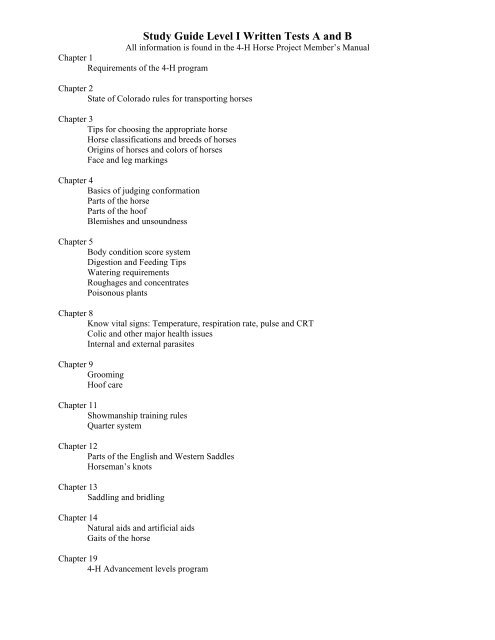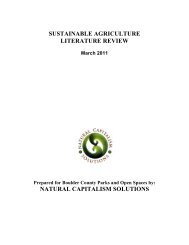Study Guide Levels I-IV Written Tests - Colorado State University ...
Study Guide Levels I-IV Written Tests - Colorado State University ...
Study Guide Levels I-IV Written Tests - Colorado State University ...
Create successful ePaper yourself
Turn your PDF publications into a flip-book with our unique Google optimized e-Paper software.
<strong>Study</strong> <strong>Guide</strong> Level I <strong>Written</strong> <strong>Tests</strong> A and B<br />
All information is found in the 4-H Horse Project Member’s Manual<br />
Chapter 1<br />
Requirements of the 4-H program<br />
Chapter 2<br />
<strong>State</strong> of <strong>Colorado</strong> rules for transporting horses<br />
Chapter 3<br />
Tips for choosing the appropriate horse<br />
Horse classifications and breeds of horses<br />
Origins of horses and colors of horses<br />
Face and leg markings<br />
Chapter 4<br />
Basics of judging conformation<br />
Parts of the horse<br />
Parts of the hoof<br />
Blemishes and unsoundness<br />
Chapter 5<br />
Body condition score system<br />
Digestion and Feeding Tips<br />
Watering requirements<br />
Roughages and concentrates<br />
Poisonous plants<br />
Chapter 8<br />
Know vital signs: Temperature, respiration rate, pulse and CRT<br />
Colic and other major health issues<br />
Internal and external parasites<br />
Chapter 9<br />
Grooming<br />
Hoof care<br />
Chapter 11<br />
Showmanship training rules<br />
Quarter system<br />
Chapter 12<br />
Parts of the English and Western Saddles<br />
Horseman’s knots<br />
Chapter 13<br />
Saddling and bridling<br />
Chapter 14<br />
Natural aids and artificial aids<br />
Gaits of the horse<br />
Chapter 19<br />
4-H Advancement levels program
<strong>Study</strong> <strong>Guide</strong> Level II <strong>Written</strong> <strong>Tests</strong> A and B, 2011 Revision<br />
All information is found in the 4-H Horse Project Member’s Manual<br />
Chapter 3<br />
Breeds of horses and their origins<br />
Colors and coat patterns<br />
Characteristics and uses of various breeds<br />
Cross bred horses<br />
Definitions of life stages and sexes of horses<br />
Teeth<br />
Chapter 4<br />
Definitions and locations of blemishes, lameness and unsoundness<br />
Chapter 5<br />
Digestion<br />
Types of Nutrients and value of them<br />
Basic requirements of a good pasture<br />
Differences between concentrates and roughages and how they are fed<br />
When and how to change a horse’s diet<br />
Feeding tips<br />
Chapter 6<br />
Requirements of good pasture and its management<br />
Chapter 8<br />
Review common health problems, their symptoms, cause and treatment<br />
External and internal parasites<br />
Vaccinations<br />
Chapter 14<br />
Riding aids and gaits, including footfall patterns<br />
Forehand and hindquarter turns<br />
Two tracking and shoulder in<br />
Counter canter<br />
Chapter 17<br />
Approaching and handling the horse<br />
Fire safety<br />
Chapter 19<br />
4-H Advancement levels program
Chapter 3<br />
Coat markings<br />
Aging by teeth<br />
<strong>Study</strong> <strong>Guide</strong> Level III <strong>Written</strong> Test, 2011 Revision<br />
All information is found in the 4-H Horse Project Member’s Manual<br />
Chapter 4<br />
Differences between blemishes and unsoundnesses<br />
Types of blemishes, lameness and unsoundness: causes and treatment, if any<br />
Parts of the horse<br />
Parts of the hoof<br />
Correct and incorrect leg structure and resulting travel<br />
Chapter 5<br />
Body condition scoring system<br />
Protein values of feed<br />
Major nutrients and what they provide<br />
Chapter 7<br />
Housing and fencing<br />
Chapter 8<br />
Internal and external parasites<br />
First aid<br />
Vital signs<br />
Diseases: causes, symptoms, treatment<br />
Immunizations<br />
Dental problems<br />
Chapter 12<br />
Horseman knots<br />
Bits<br />
Chapter 17<br />
Safety when handling horse<br />
Fire Safety<br />
Safety in Barn, paddock and pasture<br />
Horse Safety Commandments<br />
Trailering<br />
Chapter 19<br />
4-H Advancement levels program
<strong>Study</strong> <strong>Guide</strong> Level <strong>IV</strong> <strong>Written</strong> Test<br />
Answers available in the 4-H Horse Project Member’s Manual and The Horse, Evans, et al.<br />
Chapter 3<br />
Basic body colors and markings<br />
Breeds: origins, characteristics and uses<br />
Teeth: types and aging by teeth, malformations<br />
Chapter 4<br />
Blemishes, lameness and unsoundness: definitions and differences<br />
Conformation considerations: positive and negative<br />
Chapter 5<br />
Type of Nutrients<br />
Types of Hay – timothy, grass, alfalfa, legume hay, etc., values of same<br />
Calcium to phosphorous ratio in horses<br />
Common poisonous plants of <strong>Colorado</strong>; symptoms and affected parts of the horse<br />
Chapter 6<br />
Pasture management<br />
Chapter 8<br />
Vital signs: What they are, where and how to take them<br />
Common health problems: causes, diagnosis, tests, treatments, immunizations<br />
Internal and external parasites: types, diagnosis, treatment, management<br />
The Horse<br />
Colors: dilution of color genes and resulting colors<br />
Purpose of the pancreas, liver, kidneys and heart<br />
Sign(s) of a diet too high in protein<br />
Ectoparasites<br />
Coprophagy<br />
Retained placenta<br />
Gestation time<br />
Body systems: Skeletal, muscular, respiratory, circulatory, integumentary, digestive,<br />
nervous, endocrine, reproductive<br />
Know the parts of the horse that make up these systems

















